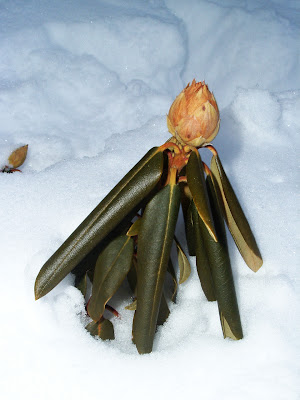 Monarda didyma
Monarda didyma, known in English as bee balm, bergamot, Oswego tea, or firecracker plant, and in French as
monarde,
thé d'Oswego,
bergamote, or
mélisse d'or is a perennial in the mint family native to much of eastern North America, and also the northwestern United States. Its flowers are very unusual and hard to describe—some say they look like jester's hats or fireworks; and are a lovely red.
I collected some of the seedheads from our plant in the fall; they look like prickly dark brown pompoms. They come apart into papery tubes about 1 cm long which are open at one end; at the closed end (closer to the centre of the pompom) of each tube is a tiny black seed; at least, I hope it is a seed.
Since this is a native plant, I am assuming it needs to go through a Canadian winter, or at least part of it, to germinate, so I am wintersowing it.
 Platanus occidentalis, known in English as American sycamore and in French as platane d'occident, is a deciduous tree native to eastern North America. In Canada, sycamore is considered an indicator species for the unique Carolinian ecoregion in southern Ontario.
Platanus occidentalis, known in English as American sycamore and in French as platane d'occident, is a deciduous tree native to eastern North America. In Canada, sycamore is considered an indicator species for the unique Carolinian ecoregion in southern Ontario.
![[Photo: Echinacea purpurea in winter.]](https://blogger.googleusercontent.com/img/b/R29vZ2xl/AVvXsEjwrlNHzmRgTLKx-eboU1FZKcRhxXkSFfnrntq-BxCw_ElImsv8ad6B-Blywke2LQdjvhI7sUcsHU1JWHjVTNFpgB1NL75M9viV1yB7TuVqn4Lrtn24A7fjy9hHCE3MwyiesTW4MBLSjUU/s400/DSCF1724.JPG)
![[Photo: Echinacea purpurea seedhead.]](https://blogger.googleusercontent.com/img/b/R29vZ2xl/AVvXsEh_sH5PregIoGXid0aOuhJ0iBvRT1UTvOA03iIGqSJV0JYLbxEVJMPLyZxCivHlN1k3fhbns6wFBYj2tdTU7Qb40zgJhjudCdIaCO23AA0U8cHL-ZhdIkrsQP7-SmuQrWMvfsaeRxc0m8Q/s400/DSCF1725.JPG)



![[Photo: Liatris spicata in winter.]](https://blogger.googleusercontent.com/img/b/R29vZ2xl/AVvXsEhfbp0rFZqZQ60Y60ffhDqW36I3obaiUdGqCW-TFVWihVhKI2vz54XPvpRs3I7Yzoj61tf11yTbpXbvpy5cXs0oH5_okDqNZP8OxHO0-_y4v36Dbpx5jq5gTDyjw1VMt8iUCCP53Yc6TKw/s400/DSCF1719.JPG)

![p[Photo: Sedum 'Autumn Joy' in winter.]](https://blogger.googleusercontent.com/img/b/R29vZ2xl/AVvXsEgsieW0lmlGVmhcY9GmFeWlSflXiyEQ1Ufrtyljb84j4zH2mBnou5jvCYmzN1XQtKj23tzb3owE5bG1_DG1aj8ECTLlQ1clue1c0Mn3Tiqnz1iOLxV2xae1xV_R1c1hacwZeT8AB4ngk6M/s400/DSCF1717.JPG)






![[Photo: seeds of Lobularia maritima.]](https://blogger.googleusercontent.com/img/b/R29vZ2xl/AVvXsEhbNubc5sI3M7UkqlQUt2Tmhei8E02sIUSmFLq70YrORFWHKFnRxJEgaM7ODrgz6SRN1459jIUcFFx9Cb05TQnrAnLCmRxJkULlnsIUWFJPq34croErRXhNi4lsuKiO1-FMdDQYr-djpLU/s320/DSCF1707.JPG)


![[Photo: seeds of Rudbeckia hirta (black-eyed Susan).]](https://blogger.googleusercontent.com/img/b/R29vZ2xl/AVvXsEjHsy5RBK1BdXAQSHz5jigUvHVRz1Isz7R7_ZKRtOxn9fmqSt65H9R14e-eNvFKJ4sE3lFQiFI9Bewj6cL2yQ_DaNeBJpUIwkCJQCCZEonp48A45f9XFEunR6ImgfjgDUKhKTCE7N9TfnU/s320/023.JPG)
![[Photo: Seeds of Penstemon digitalis.]](https://blogger.googleusercontent.com/img/b/R29vZ2xl/AVvXsEizf4gJNfbwpDCz6iyy0kt4ycVMvXVLyoMDdHJg-fNCyGrTkI_YRIm71Vwd2rfwNr8APgiVok9AYzOLO_ryELj6jSBCkytVGwsCJLj9i-RjWStrXRDQj_D3Mp874SiMi0iPmRoeFgy2IXk/s320/021.JPG)
![[Photo: seeds of Campanula rotundifolia (harebell).]](https://blogger.googleusercontent.com/img/b/R29vZ2xl/AVvXsEjPEM2d8eAc2VOEI4n0g7s3XHprzrDXkHXml92g4IrnOPJQxlKAE1beccRrI1Xf8ktMmn8iUs66T-klCBl5ce2q2rm-XngYGwlTJpohvAbChCo_V8u7RaXx408iwdaT0sUD4lIGwhVs2fs/s320/017.JPG)


 Here are lists of all the plants mentioned in this blog.
Here are lists of all the plants mentioned in this blog.








